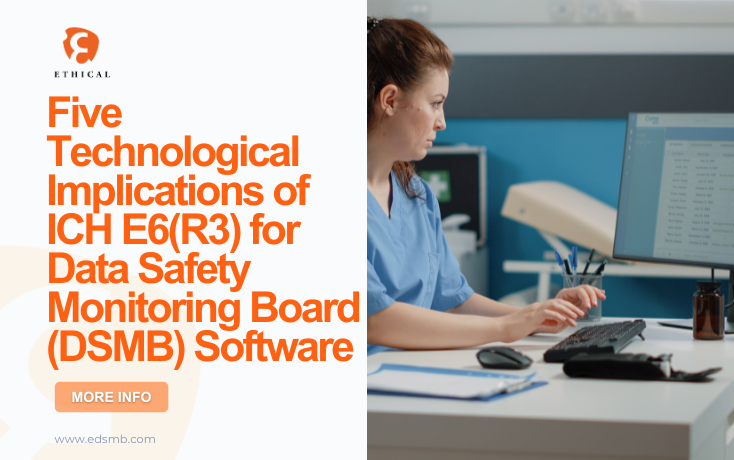The new ICH E6(R3) Good Clinical Practice guideline introduces important changes to the way clinical trials are conducted — and consequently to the capabilities required from the software that supports DSMBs. Here’s what clinical development leaders should know.
As clinical trials become more complex and decentralized, the role of Data Safety Monitoring Boards (DSMBs) is more challenging— and more critical— than ever. The new ICH E6(R3) guidance directly addresses the shift in data sources and collection, introducing updated expectations for risk-based oversight, data integrity, and the ability to manage a wider range of data sources, including real-world data (RWD) and patient-generated health data (PGHD). This has clear implications for DSMB management software. For clinical development leaders evaluating their trial oversight capabilities, it is no longer enough to rely on basic document-sharing or static safety reports. The software that supports DSMBs must also evolve to enable dynamic, traceable, and regulatory-ready operations.
Here are five key technological shifts clinical leaders should be aware of:
1. Risk-Based Safety Monitoring
Under ICH E6(R3), DSMBs are explicitly expected to tailor their monitoring strategies to the complexity and risk profile of each trial.
Software must support this with:
✅ Real-time visualizations of key safety signals.
✅ Configurable alerts based on predefined thresholds and evolving risk assessments.
✅ Layered access to relevant risk indicators for different board members and stakeholders.
This supports a progressive shift from passive review to active, adaptive risk management — an approach that DSMB platforms must prepare to integrate in the future.
2. Data Governance and Integrity
ICH E6(R3) puts a strong emphasis on traceability and data integrity. For DSMBs, this means that all data viewed and all decisions made must be:
✅ Fully auditable.
✅ Properly version-controlled.
✅ Logged in inspection-ready formats that support GxP compliance.
DSMB software must be built on a GxP-compliant infrastructure with robust audit trails and clear role-based access control — ensuring regulatory agencies can verify how safety data was reviewed and acted upon.
3. Remote and Decentralized Capabilities
As decentralized approaches grow more common, DSMBs will also increasingly operate in virtual and hybrid formats. ICH E6(R3) anticipates this reality.
Software must now support:
✅ Secure, role-based remote access to DSMB materials and safety data.
✅ Virtual DSMB meetings, with the ability to review interim data and collaborate on recommendations.
✅ Confidentiality and blinding protections, even across distributed environments.
This ensures that decentralization does not compromise the rigor and confidentiality of DSMB operations.
4. Real-World and Digital Health Data Integration
Annex 2 of ICH E6(R3) reinforces the use of real-world data (RWD) and patient-generated health data (PGHD) in clinical trials.
For DSMBs, this means platforms must be able to:
✅ Consider diverse data sources such as electronic health records (EHRs), wearable device data, and ePROs.
✅ Present these data streams in ways that support early detection of safety signals.
✅ Handle complex data integration without sacrificing transparency or data integrity.
This shift will ultimately move DSMBs beyond traditional safety monitoring and into a new era of integrated, multi-source oversight.
5. Regulatory-Ready Documentation
Finally, ICH E6(R3) emphasizes the need for transparent, readily inspectable documentation.
Software must enable:
✅ Automated logging of all interim analyses, meeting minutes, and DSMB recommendations.
✅ Version-controlled storage of all regulatory-relevant records.
✅ Seamless preparation for inspection, reducing the manual effort required for regulatory submissions.
This level of documentation is critical to demonstrate compliance and accountability — and is now expected as standard.
Conclusion:
The new ICH E6(R3) guidance highlights how much the role of DSMBs — and the technology that supports them — is posed to evolve. Risk-based oversight, decentralized operations, integrated data streams, and rigorous documentation are becoming part of the new standard for clinical trial safety monitoring. Clinical development leaders must ensure that their DSMB software platforms are preparing to meet these expectations and future-proof their trial oversight.
Is your DSMB software ready for ICH E6(R3)?
At Ethical, we help sponsors and CROs streamline their DSMB operations with software built for the latest regulatory standards. Contact us through the form below to learn how our solutions can help you stay ahead.




